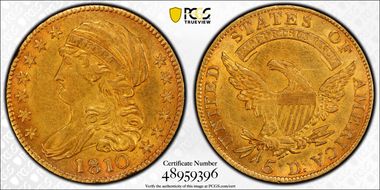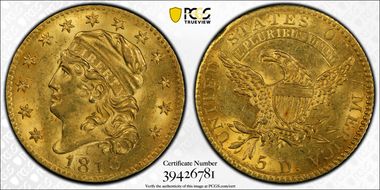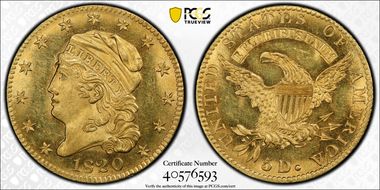Pumpkin Collection SCARSDALE COIN 的钱币相册
1812 $5 MS 62 PCGS. Wide 5D. Ex: Bass Collection. B. 1-B. Miller-118, R.3. Sold as lot 801 in the second offering of Bass coins, where it was described as, "Sharply struck with very attractive light orange-gold lustre. Minor surface marks do not distract from the aesthetic appeal. Heavy obverse and reverse clash marks. No die cracks are noted." Ex: Bass II (Bowers and Merena, 10/99), lot 801, where it realized $8,912.50; purchased by Bass from A-Mark Coin Co., March 16, 1978.
1813 $5 BD-1, R.2, MS62 PCGS. CAC. Ex: King Farouk. Bass-Dannreuther Die State a/a. The 1813 is the first issue of the Capped Bust Left type, which, as a whole, was subject to extensive hoarding and melting as gold was driven out of circulation. This date was saved to a much greater extent than later issues, with 450 to 650 survivors of the BD-1 die pair alone. BD-1 representatives are distinguished from their BD-2 counterparts by the placement of the first S in STATES over the right side of the E on the ribbon below. The present example was sold as part of the King Farouk holdings in 1954. Maurice Storck attended that famous sale and likely purchased the coin either directly at auction or soon after from one of the other dealers in attendance. Orange accents appear over lustrous yellow-gold surfaces that show only minor disturbances in the fields. The overall impression is bold with minor roller marks on the portrait and lower obverse border. Eye appeal is tremendous. A perfect type coin with a great provenance. Ex: King Farouk; Palace Collections of Egypt (Sotheby's, 2/1954), lot 233. From The Maurice Storck Collection.
1813 $5 BD-1, R.2, MS62 PCGS. CAC. Ex: King Farouk. Bass-Dannreuther Die State a/a. The 1813 is the first issue of the Capped Bust Left type, which, as a whole, was subject to extensive hoarding and melting as gold was driven out of circulation. This date was saved to a much greater extent than later issues, with 450 to 650 survivors of the BD-1 die pair alone. BD-1 representatives are distinguished from their BD-2 counterparts by the placement of the first S in STATES over the right side of the E on the ribbon below. The present example was sold as part of the King Farouk holdings in 1954. Maurice Storck attended that famous sale and likely purchased the coin either directly at auction or soon after from one of the other dealers in attendance. Orange accents appear over lustrous yellow-gold surfaces that show only minor disturbances in the fields. The overall impression is bold with minor roller marks on the portrait and lower obverse border. Eye appeal is tremendous. A perfect type coin with a great provenance. Ex: King Farouk; Palace Collections of Egypt (Sotheby's, 2/1954), lot 233. From The Maurice Storck Collection.
B. 1-A, Miller-121, the only known dies, High R.5. Produced to the extant of only 15,454 pieces, the 1814/3 is a difficult issue to locate in today''s market. Extant representatives are scarcer than their 1813 and 1818 counterparts and the encountered grade is likely to be in the VF or XF range.
The 1827 half eagle is a well-known melt rarity with an estimated three dozen known from a mintage which is estimated to be 24,913 coins. This issue saw little circulation, and the majority of the survivors are Uncirculated, including a few Gems. It is difficult to imagine a more aesthetically appealing example for the grade, with both the obverse and the reverse showing very deep natural orange-gold colors which flash reddish-gold hues when the coin is tilted towards a light source. There is no real wear seen on either side and this coin has what used to be referred to as “cabinet friction” on the high spots. One very thin scratch in the left obverse field is barely noticeable with the naked eye, and this is an exceptionally attractive coin.
The 1827 half eagle is a well-known melt rarity with an estimated three dozen known from a mintage which is estimated to be 24,913 coins. This issue saw little circulation, and the majority of the survivors are Uncirculated, including a few Gems. It is difficult to imagine a more aesthetically appealing example for the grade, with both the obverse and the reverse showing very deep natural orange-gold colors which flash reddish-gold hues when the coin is tilted towards a light source. There is no real wear seen on either side and this coin has what used to be referred to as “cabinet friction” on the high spots. One very thin scratch in the left obverse field is barely noticeable with the naked eye, and this is an exceptionally attractive coin.































